|
|
Development of SiO2/C and SiC/C Composites Featuring Aerogel Structures
HE Fei, LI Ya, LUO Jin, FANG Min-Han, HE Xiao-Dong
2017 Vol. 32 (5): 449–458
 Abstract
Abstract(
1486 )
 HTML
HTML(
30)
 PDF
PDF(465KB)(
2135
)
C/SiO2 and C/SiC composites featuring the structures of aerogels possess diverse structural characteristics. Due to their unique properties, such as porosity, low density and high temperature resistance, C/SiO2 and C/SiC composites can be widely applied in the fields including high temperature thermal insulation, absorption, catalysis, hydrogen storage, and photoelectricity. In this paper, an overview of the literature is presented on C/SiO2 and C/SiC composites featuring aerogel structures. According to the introducing methods of silicon and carbon sources, these composites can usually be synthesized by three methods: co-polymerization, impregnation and polymeric precursor pyrolysis. The technological characteristics of the three methods are discussed in accordance with relative existence between carbon and silica. Meanwhile, the characteristics of microstructures, crosslinking mechanisms and the physical properties are analyzed. Some researchful proposals for further developments are proposed. In our opinions, the diverse methods of compositing carbon and silicon result in various characteristics and properties of C/SiO2 and C/SiC composites, which expands relevant research fields.
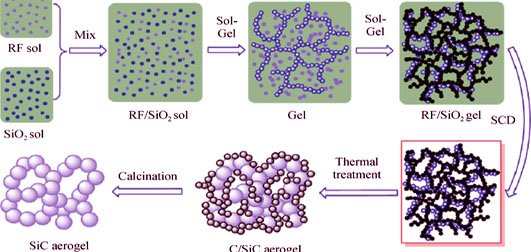
|
|
|
Recent Advances on Synthesis and Supercapacitor Application of Binary Metal Oxide
TIAN Xiao-Dong, LI Xiao, YANG Tao, SONG Yan, LIU Zhan-Jun, GUO Quan-Gui
2017 Vol. 32 (5): 459–468
 Abstract
Abstract(
1735 )
 HTML
HTML(
20)
 PDF
PDF(661KB)(
1682
)
Supercapacitors (SCs) have been regarded as ‘bridges’ between traditional capacitors and batteries, and the integrated performance of SC is essentially determined by its electrode materials. It is found that the capacitance of pseudocapacitive electrode materials can be ten times higher than that of carbon-based electrode materials. As one of the most promising electroactive materials, binary transition metal oxides (BTMOs) and their corresponding composites have been widely studied for energy storage due to their rich redox properties involving multiple oxidation states and different ions. This review presents an extensive description of BTMO materials and the most commonly used synthetic methods. Furthermore, several notable BTMOs and their composites in the application of SCs are reviewed and their prospect and direction of development as well as the scientific problems remaining to be solved are pointed out.
|
|
|
Performance of Nd2NiO4+δ-Ce0.8Gd0.2O2-δ Composite Cathodes for Intermediate Temperature Solid Oxide Fuel Cells
LI Si-Lin, TU Heng-Yong, YU Li-Jun
2017 Vol. 32 (5): 469–475
 Abstract
Abstract(
886 )
 HTML
HTML(
7)
 PDF
PDF(506KB)(
877
)
Nd2NiO4+δ (NNO)-Ce0.8Gd0.2O2-δ (CGO) composites were further investigated as cathodes for intermediate temperature solid oxide fuel cells (IT-SOFCs). The effects of sintering temperature and the relative proportions of NNO and CGO on the cell performances were systematically investigated. Planar NiO-YSZ anode-supported cells in commercial size of 50 mm×50 mm were fabricated by tape casting, screen printing and co-sintering methods. A single cell consisted of a NiO-YSZ anode support, a NiO-YSZ anode interlayer, a YSZ electrolyte layer, a CGO interlayer, a NNO-CGO composite cathode layer, and a La0.6Sr0.4CoO3-δ (LSC) current collector from anode to cathode. The results show that the cell with 70NNO-30CGO composite cathode sintered at 1000℃ exhibits the highest power density of 385 mW/cm2 at 0.7 V at 800℃. The ohmic resistance, polarization resistance and area specific resistance are 0.31, 0.266 and 0.576 Ω·cm2, respectively. The analysis of electrochemical impedance spectra indicates that the polarization resistance mainly comes from charge transfer resistance. SEM image of the cross-section of the cell after testing reveals that each layer has a good adhesion. Meanwhile, compared with previous research, it can be concluded that adding a CGO interlayer in the single cells leads to an increase in the ohmic resistances and a decrease in the power densities, whereas the values of the polarization resistances decrease.
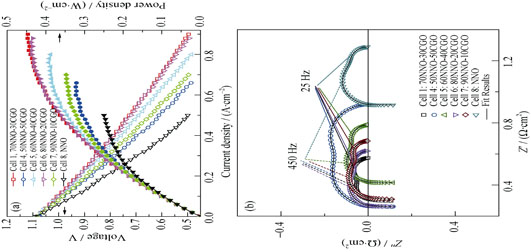
|
|
|
Synthesis and Electrochemical Performance of LiMn0.6Fe0.4PO4/C Cathode for Lithium-ion Batteries
LI Wei, ZHANG Yuan-Jie, WANG Xuan-Peng, NIU Chao-Jiang, AN Qin-You, MAI Li-Qiang
2017 Vol. 32 (5): 476–482
 Abstract
Abstract(
850 )
 HTML
HTML(
9)
 PDF
PDF(786KB)(
1192
)
The LiMn0.6Fe0.4PO4/C cathode for lithium-ion batteries (LIBs) was synthesized by solvothermal, ball-milling combined with solid phase calcination method using sucrose as a carbon source and oxalic acid as an antioxidant. The final products with different morphologies were obtained by changing sintering temperatures. The structure and morphology of the target products were characterized by X-ray diffraction (XRD) and scanning electron microscopy (SEM). Cyclic voltammetry and galvanostatic charge and discharge tests were employed to characterize the electrochemical properties of the samples. The results manifest that well-crystallized olivine structure LiMn0.6Fe0.4PO4/C nano-rods and nano-spindles with no obvious impurity phase are obtained. The spindle-like LiMn0.6Fe0.4PO4/C sample S-650 (which was sintered at 650℃) shows a highly monodisperse and homogeneous morphology. Electrochemical analysis results demonstrate that S-650 exhibits the best electrochemical performance with an initial discharge capacity of 119.1 mAh/g at the current density of 0.2 C (1 C=170 mA/g), and a capacity of 148.8 mAh/g is achieved after 80 charge-discharge cycles, in comparison with S-600 (which was sintered at 600℃) and S-700 (which was sintered at 700℃). Meanwhile, S-650 also demonstrates excellent cycling stability even at a high current density of 2C.
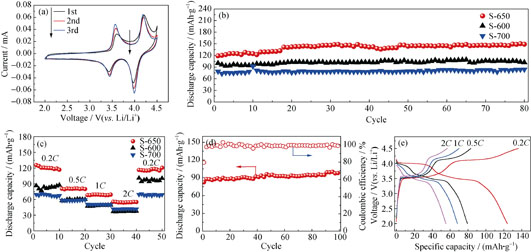
|
|
|
Fabrication and Lithium Storage Performance of ZnO-C Three Dimensional Network Coatings
SUN Tao, YANG Qi, YU Jia-Yu, MA Jin-Xin
2017 Vol. 32 (5): 483–488
 Abstract
Abstract(
571 )
 HTML
HTML(
3)
 PDF
PDF(533KB)(
906
)
Cu-supported ZnO-C composite coatings with three dimensional (3D) network structures were successfully fabricated through simple knife coating technique. The structure and morphology of the as-prepared samples were characterized by X-ray diffraction (XRD), Raman spectrum (Raman), scanning electron microscope (SEM) and transmission electron microscope (TEM). The results show that the coatings are constructed by interconnected carbon based branches with a width of 0.1-1 μm containing ZnO nano-particles and micro-pores with a size of ~2 nm. The Cu-supported ZnO-C composite coatings can be directly employed as anodes of lithium-ion batteries (LIBs). The electrochemical test demonstrates that at a current density of 0.1 A/g, the ZnO-C composite coating electrodes exhibit specific capacity of 855 mAh/g after 100 cycles without capacity fading during cycling; at a high current density of 5 A/g, the electrodes deliver specific capacity of 418 mAh/g, which is 51.3% of the specific capacity at a current density of 0.1 A/g.
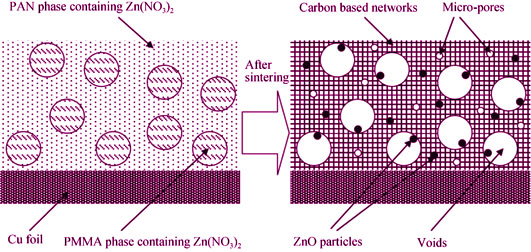
|
|
|
Influence of Sintering Temperature and CaTiO3 Doping on Structure and Dielectric Properties for Instability Layered Can+1TinO3n+1 (n = 1) Ceramics
LIU Fei, HUANG Xian-Pei, YUAN Chang-Lai, CHEN Guo-Hua
2017 Vol. 32 (5): 489–494
 Abstract
Abstract(
792 )
 HTML
HTML(
6)
 PDF
PDF(484KB)(
1070
)
Ca2TiO4+xwt% CaTiO3 (x=0, 0.8, 1.6 and 3.2) ceramics were prepared by solid state reaction technique. The relation between phase compositions and structures, microstructures, sintering temperatures, and microwave dielectric properties of these ceramic systems were accordingly studied. XRD patterns revealed that the main phase of the undoped CaTiO3 in Ca2TiO4 ceramic systems was closely related with the sintering temperature, and the crystal phase transited from the orthorhombic CaTiO3 phase (as sintered at 1400℃) to tetragonal Ca3Ti2O7 phase (as sintered at 1420℃). In addition, the CaTiO3-doping in various amounts resulted in the change of main phase with the sintering temperature increasing from 1420℃ to 1450℃. Wherein, the stability and high-content Ca3Ti2O7 phase could be obtained by doping 1.6wt%-3.2wt% CaTiO3. The microwave dielectric properties test showed that the undoped Ca2TiO4 multiphase systems got a great reduction in the εr, Q×f and τf values from 59.04, 2340 GHz and 93.13×10-6/℃ (as sintered at 1400℃) to 59.04, 2340 GHz and 93.13×10-6/℃ (as sintered at 1420℃), respectively. Additionally, the various amounts of CaTiO3-doping could keep the Q×f values stably to some extent for the Ca2TiO4 ceramic systems.
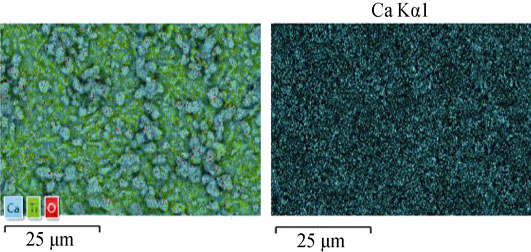
|
|
|
Effects and Oxidation Kinetics of Holding Time on the β-Sialon Bonded MgAl2O4-C Composites
SONG Yun-Fei, WANG Shao-Hua, DENG Cheng-Ji, ZHU Hong-Xi, LIU Jian-Peng, DING Jun, YU Chao
2017 Vol. 32 (5): 495–501
 Abstract
Abstract(
527 )
 HTML
HTML(
1)
 PDF
PDF(587KB)(
911
)
A β-Sialon bonded MgAl2O4-C refractory was prepared in-situ by fused spinel, silicon powder, flake graphite as raw materials, and calcium lignosulfonate with the concentration of 1.25 g/mL as the binder. The samples were sintered under N2 atmosphere at 1450℃ for 1, 2 3 and 4 h, respectively. The effects of holding time on the conventional physical properties, phase compositions and microstructure of MgAl2O4-C refractory were investigated. The phase composition and microstructure of the sintered samples were investigated by X-ray diffraction (XRD) and Scanning Electron Microscope (SEM), respectively. XRD patterns showed that there were no evident differences on the phase compositions and the silicon phase had completely disappeared to form SiC, Si3N4 or β-Sialon (Si3Al3O3N5). The β-Sialon crystals had columned microstructure stagger on each other when holding time was 3 h. With the holding time increasing from 1 h to 4 h, the increased SiO gas lead to an increase of apparent porosity and a decrease of bulk density. In addition, the cold crushing strength and flexural strength of the samples sintered at 1450℃ for 3 h reach the highest. Research on oxidation kinetics of composite material indicates that oxidation process can be divided into three stages: chemical reaction rate controlling stage, diffusion rate controlling stage, and co-effect controlling of chemical reaction and diffusion rate stage.
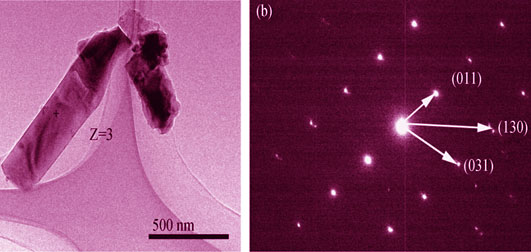
|
|
|
Effect of Forming Pressure on Microstructure and Mechanical Properties of SiC/TiB2 Composites
ZHANG Cui-Ping, GAO Xiang-Wei, RU Hong-Qiang, SUN Wei-Kang, ZHU Jing-Hui, ZONG Hui
2017 Vol. 32 (5): 502–508
 Abstract
Abstract(
614 )
 HTML
HTML(
4)
 PDF
PDF(724KB)(
1051
)
SiC/TiB2 composites were fabricated by infiltration of molten silicon (Si) into porous preforms containing titanium diboride (TiB2) and free carbon (C) at 1550℃ for 30 min. And the influences of forming pressure on the phase compositions, microstructure, density and mechanical properties of SiC/TiB2 composites were investgated. It is found that forming pressures have significant influence on the microstructure and mechanical properties of SiC/TiB2 composites. XRD results show that the composites consist of TiB2, SiC and Si phases. The microstructure analysis show that the TiB2 and SiC phases distribute in the composite uniformly, with free Si fills in the continuous gaps between TiB2 and SiC phases. TiB2 particle size and volume fraction of free Si both decrease with the increase of forming pressures. The mechanical properties of SiC/TiB2 composites are improved initially and then deteriorated with the increase of forming pressures. Under the optimal pressure of 200 MPa, Vikers-hardness, flexural strength and fracture toughness of the obtained SiC/TiB2 composite are (21.0±1.1) GPa, (354±16) MPa and (6.8±0.2) MPa·m1/2, respectively. The open porosity and bulk density of the obtained SiC/TiB2 composite prepared at 200 MPa forming pressure are 0.90% and 3.63 g/cm3.
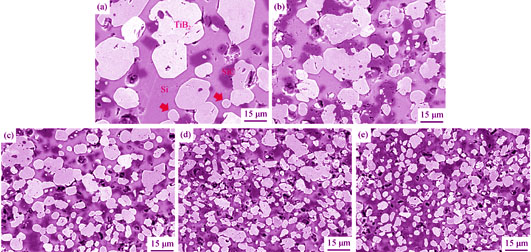
|
|
|
Effect of hBN Content on Property and Microstructure of Si3N4-hBN Composite Ceramics
ZHANG Chang-Song, LIU Qiang, CHEN Wei
2017 Vol. 32 (5): 509–516
 Abstract
Abstract(
754 )
 HTML
HTML(
7)
 PDF
PDF(1069KB)(
1451
)
Si3N4-hBN composites were prepared using hot-press method with nano-scaled powder, the influence of hBN content on density, mechanical properties, tribological properties, microstructure of Si3N4-hBN composites were investigated. The density and mechanical properties of composites were measured by Archimedes method, three point bending method and Vickers indentation method. The tribological properties of composites were measured by friction and wear tester. The phase composition and microstructure of composites were analyzed and observed by XRD, EDAX and SEM, LSCM. The results showed that with increase of hBN content the composites’ density gradually decreased, the composites’ porosity increased at first and then stable gradually, the composites’ mechanical performance gradually decreased. The friction tests indicated that the tribological properties of Si3N4-hBN and GCr15, with pair under dry friction, increased at first and then decreased sharply with the increase of hBN content. The friction coefficient and wear coefficient decreased gradually when hBN content was less than 20%, and then increased sharply when the hBN content was more than 20%. The friction coefficient reaches the lowest value of 0.31 when the hBN content was about 20%. The addition of hBN influenced the mechanical and tribological properties of Si3N4-hBN composites through directly influenced its microstructure.
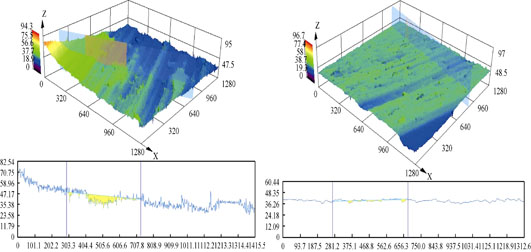
|
|
|
Synthesis of the Nitrogen-doped CVD Graphene through Triazine
LIU Ying, DAI Dan, JIANG Nan
2017 Vol. 32 (5): 517–522
 Abstract
Abstract(
590 )
 HTML
HTML(
2)
 PDF
PDF(529KB)(
1032
)
Nitrogen-doped graphene (N-graphene) was prepared via molecular doping from symTriazine molecules at low temperature. The phase structure, morphology and electrical property were characterized by Raman spectroscopy (Raman), X-ray photoelectron spectroscope(XPS), atomic force microscope (AFM), ultraviolet spectrophotometer(UV), and Hall tester. Here the method provides a simple and safe process to grow N-graphene. The morphology of N-graphene retains good uniformity, and the transmittance of the graphene is 95% in the range from 300 nm to 800 nm. The typical graphene peaks G-band and 2D-band both upshift after doping. The hole-carrier concentration is decreased immediately after Triazine decoration. After exposure to Triazine for 3 h, the charge-carrier concentration of N-graphene remains as high as 4×1012/cm2, which approaching the pristine Chemical Vapor Deposition (CVD) graphene’s carrier concentration due to the abundant molecular doping. After N-graphene annealed at 450℃, a hole-carrier concentration of ~8×1012/cm2 can be regenerated. The sheet resistance of N-graphene can stay steady at 300℃. The mechanism of Triazine doping is that Triazine is an electron-rich aromatic molecule due to the incorporation of N atoms in the aromatic ring, and some negative charges are expected to transfer onto the graphene. This research provides a simple method to obtain N-graphene doping for future application in electrical devices.
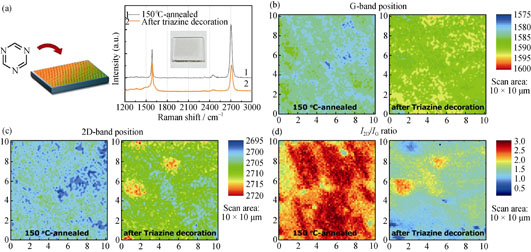
|
|
|
Preparation, Characterization and Antimicrobial Activity of Core-satellite Ag/PDA@SiO2@CoFe2O4 Magnetic Composites
LIAO Fan, MA Jian-Qi, GE Hong-Guang
2017 Vol. 32 (5): 523–528
 Abstract
Abstract(
957 )
 HTML
HTML(
9)
 PDF
PDF(407KB)(
1502
)
Monodisperse submicron CoFe2O4 spheres were prepared by solvothermal method. Polydopamine-coated silica@CoFe2O4 composite particles were synthesized by combination of Sol-Gel process and in situ self-polymerization method, in which tetraethyl orthosilicate (TEOS) and dopamine were used as the precursor for silica and polydopamine (PDA), respectively. The PDA@SiO2@CoFe2O4 composites had a multilayer core-shell structure with PDA as the outermost layer shell. Then, numerous of silver nanoparticles were assembled on the surface of PDA@SiO2@CoFe2O4 via the reduction of Ag+ by the surface PDA on the composites. The morphology, structure, and composition of the composites were characterized by transmission electron microscope (TEM), X-ray powder diffraction (XRD), X-ray photoelectron spectrometry (XPS), vibrating sample magnetometry (VSM), and inductively coupled plasma optical emission spectrometry (ICP-OES). Antibacterial experiments indicated that the as-prepared composites could restrict up to 92% Escherichia Coli (E.Coli) and Staphylococcus Aureus (S.Aureas) at 0.6 mg/mL Ag. In addition, the composites showed a strong magnetic response to an externally applied magnetic field, so it could be reused.
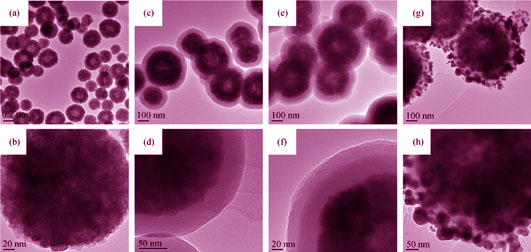
|
|
|
Synthesis and Characterizations of B2O3-SiO2-Na2O Controlled-release Antibacterial Agent
SHI Rui-Rui, LI Meng, PEI Yuan-Sheng
2017 Vol. 32 (5): 529–534
 Abstract
Abstract(
546 )
 HTML
HTML(
5)
 PDF
PDF(419KB)(
1002
)
High temperature melting method has been used to synthesize B2O3-SiO2-Na2O controlled-release antibacterial agent on account of the functions that borate can inhibit the growth of bacteria and algae. The new inhibitor, a solid agent with controlled-release capability in water, is different from those liquid and gaseous antibacterial agents. In this study, the physicochemical properties of the inhibitor were characterized by XRD, SEM and FTIR. The concentrations of boron in solution were determined by using ICP-AES to determine the release capability of the inhibitor. Moreover the experiments of inhibitory circle and inhibitory rate were carried out to evaluate the antibacterial effects of the inhibitor on Escherichia Coli and Staphylococcus Aureus. The results indicate that the inhibitors present amorphous structure, with the content of [BO3] and [BO4] groups in the internal structure being affected by the amounts and the ratio of B2O3 and SiO2. The agent surface is denser while the release rate decreases with the decrease of B2O3 amount. Furthermore, the antibacterial effect enhances with the increase of boron concentration. S. Aureus is more sensitive to the inhibitor than E. Coli. The inhibitor containing 55wt% of B2O3 gets the best antibacterial effect , which exhibits better controlled-release than the others. The present results provide a reference for further research and industrial application of the antibacterial agent.

|
|
|
Porous Calcium Manganese Oxide: Preparation and Electrocatalytic Activity of Oxygen Reduction Reaction
CAO Zhao-Xia, DING Yan-Min, WANG Zhi-Chao, MAO Xin-Xin, YIN Yan-Hong, YANG Shu-Ting
2017 Vol. 32 (5): 535–542
 Abstract
Abstract(
807 )
 HTML
HTML(
8)
 PDF
PDF(701KB)(
1422
)
Calcium-manganese oxides (Ca-Mn-O) of layer-pervoskite Ca2MnO4 was firstly prepared by using calcium alginate fiber as supporter and then investigated as electrocatalysts for oxygen reduction reaction (ORR), compared with post-spinel CaMn3O6. The results of XRD, FE-SEM, TEM and BET displayed the as-synthesized layer-pervoskite Ca2MnO4 displayed interconnected porous network structure and high special surface area. The catalyst demonstrates significant electrocatalytic activity towards ORR: a high limit current density, near an apparent quasi four electron oxygen reduction, and low yield of peroxide species in alkaline solutions, which suggestes the potential application of Ca2MnO4 as cheap and abundant ORR catalysts. The catalytic activities of Ca-Mn-O oxides (onset potential, limiting current density and transferred electron number) depend strongly on the surface Mn oxidation state and the crystallographic structures. In addition, high specific surface area and porous network structure increase electrocatalytic activity sites of ORR, high concentration of oxygen vacancies favor process of ORR, appropriate crystallographic structures with open tunnels, facilitating oxygen chemisorption.
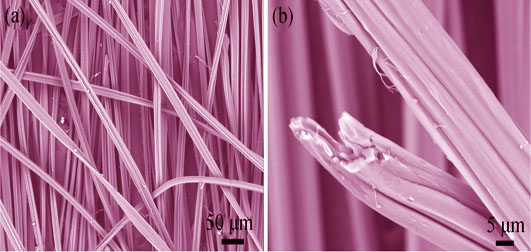
|
|
|
Mesoporous Material Co/SBA-15 as Catalyst for the Decomposition of Cyclohexyl Hydroperoxide
GUO Lu-Lu, LI Li-Xia, HE Peng-Cheng, YUAN Xia
2017 Vol. 32 (5): 543–549
 Abstract
Abstract(
665 )
 HTML
HTML(
10)
 PDF
PDF(562KB)(
915
)
A series of mesoporous material Co/SBA-15 with Co loading of 2wt%, 4wt%, 8wt%, 10wt%, and 20wt% were prepared through incipient wetness impregnation method using SBA-15 as support and cobalt acetate as Co source. The structures of obtained samples were characterized by FT-IR, X-ray diffraction (XRD), N2 adsorption-desorption, Diffuse reflectance UV-Vis, SEM, TEM, and hydrogen temperature programmed reduction (H2-TPR) techniques. Their catalytic performance in decomposition of cyclohexyl hydroperoxide were also studied. Results show that the mesoporous structure of support remains intact after loading with Co. The specific surface area, pore volume and pore diameter of Co/SBA-15 are gradually decreased with the increase of loading amount. All the samples showed excellent catalytic activity in the decomposition of cyclohexyl hydroperoxide. The 8%Co/SBA-15 showed the highest catalytic performance with a conversion of 98.1% and selectivity of cyclohexanone 70.9% and cyclohexanol 27.9%. However, the loss of Co from the lower loading amount samples resulted in catalytic performance decreased significantly after reuse. Only when the loading of Co increases to 20% mainly in the form of Co3O4, the loss rate of Co can be inhibited and the catalytic activity and selectivity of recovered catalyst remain constant after using for five times.
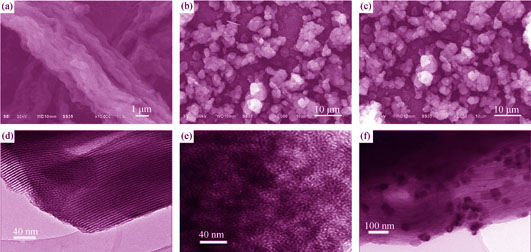
|
|
|
Performance Study of TiO2-Au Photoelectric Nanocomposites for Novel Neuromodulation
JIANG Li, LIU Jia-Nan, FAN Wen-Pei, LIU Yan-Yan, NI Da-Long, BU Wen-Bo
2017 Vol. 32 (5): 550–554
 Abstract
Abstract(
929 )
 HTML
HTML(
21)
 PDF
PDF(506KB)(
971
)
A novel noninvasive yet highly efficient neuromodulation method via photoelectric nanocomposites (NCs) was proposed. The NCs were constructed by Au nanoparticles-attached TiO2 nanocrystals. Upon 405 nm light exposure, the photocurrent was enhanced when the pure TiO2 nanocrystals were modified with Au nanoparticles. It is evidenced that effective depolarization of NCs-treated neurons takes place upon 405 nm light illumination, certified by fluorescent dye test on PC12 cells. Furthermore, the NCs could remarkably remit the epilepsy seizures of zebrafishes, indicating that the NCs are potential candidates for curing neurological disorders.
|
|
|
Effects of La Doping on CaB6 Thin Films Prepared by DC Magnetron Sputtering
ZHANG Lin, LIU Hui-Hui, LIU Lin-Jia, ZHAO Guo-Qing, WU Yan, MIN Guang-Hui
2017 Vol. 32 (5): 555–560
 Abstract
Abstract(
510 )
 HTML
HTML(
4)
 PDF
PDF(419KB)(
871
)
Both La doped and undoped Ca1-xLaxB6 (x = 0, 0.01, 0.02, 0.03) thin films were prepared by direct current magnetron sputtering method. Morphology and thickness of these films were characterized by atomic force microscopy. Thicknesses of doped films were about twice that of the undoped films, while the grain growth of the film was much enhanced by La doping. X-ray photoelectron spectroscopy (XPS) was used for investigating the chemical composition of film surfaces. Calculated La/Ca atomic ratios were close to the theoretical values, and there were no other ferromagnetic impurities or elements especially iron existing in films. Ca0.98La0.02B6 films exhibited the highest room temperature saturation magnetization 84.54 emu/cm3. The saturation magnetization decreased with increasing film thickness. B6 vacancies may be the main source of magnetism. Other defects such as grain boundaries also affected the magnitude of magnetism.
|
|